Tired of the limitations and frequent security issues with off-the-shelf CMS options? If you're finding that conventional solutions just aren't meeting your specific needs or scaling with your growth, you're not alone.
More and more businesses are recognizing the need for a CMS that is tailored precisely to their unique demands and workflows. Forrester's 2024 Marketing Survey reveals a sharp increase in CMS investment among B2C leaders, rising from 59% to 69% in just a year, with the market expected to reach $15.3 billion by 2028.
At Greenice, we bring decades of expertise in custom CMS development, crafting systems that are not only robust and secure but also perfectly aligned with our clients' specific operational requirements. In this article, we’ll share key insights from our extensive experience, helping you understand how a custom CMS can transform your content management strategy.
Now is the ideal time for a custom CMS development. With the right approach, you can gain control over your digital landscape, ensuring your CMS scales seamlessly with your business and continues to deliver exceptional digital experiences that keep pace with user expectations and technological advancements.
Key takeaways
- CMS development approaches: There are two main approaches to CMS development: using off-the-shelf systems for quick deployment with limited customization, and custom development for tailored solutions.
- Custom development options: Custom CMS development can be approached by building from scratch or using white-label solutions to save time and money.
- Advantages and challenges of custom CMS: A custom CMS provides scalability, enhanced security, and better alignment with business operations. Challenges include higher initial costs, longer development times, and a learning curve for users.
- Development steps: The process includes planning, architecture, database and security design, front-end and back-end development, testing, launch, and maintenance.
- Cost: At Greenice, costs start at approximately $5,000 for white-label solutions and $15,000 for building from scratch, varying with project complexity.
- Our experience: We have extensive experience in creating custom CMS solutions for various industries, and we share our insights and expertise in this article.
What Is CMS development?
A Content Management System (CMS) is a powerful tool that simplifies how you create, manage, and modify website content, even if you're not very tech-savvy. Content Management System development can mean setting up a ready-to-use platform like WordPress or building a system from scratch, tailored just for your needs. The effort involved really depends on the type of CMS—no-code and low-code options are quick to set up with some room for tweaks, while full-code systems take more work but offer a fully customized experience. This flexibility lets you shape how your content flows and engages your audience, perfectly aligning with your business processes.
What types of CMS exist?
Types of CMS by programming involvement:
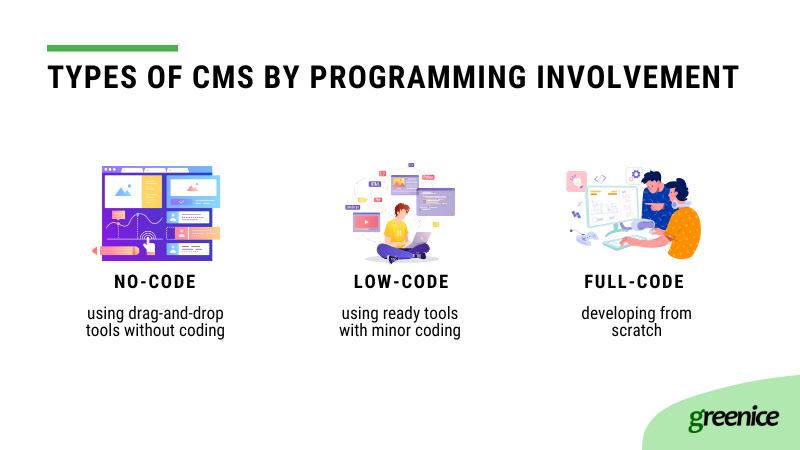
- No-code CMS: Platforms like Wix and Squarespace allow users to build websites without any coding, using drag-and-drop tools for design and setup.
- Low-code CMS: Systems like WordPress, Shopify, and Django offer user-friendly interfaces with options for minor coding to enhance functionality. White-label solutions also fit here, providing customizable bases with minimal coding required.
- Full-code CMS: This involves creating a CMS from scratch, tailored to specific needs using extensive programming. It's ideal for businesses requiring unique features and customization, utilizing frameworks like Laravel.
Types of CMS by accessibility:
- Open source CMS: These systems are freely available for anyone to use, modify, and distribute, for example WordPress and Joomla.
- Proprietary CMS: Owned and maintained by a specific company, offering a more controlled environment. Examples are Adobe Experience Manager and Sitecore.
Additionally, custom CMS solutions can be categorized as built from scratch or using white-label solutions. Let’s explore each of them.
Two ways to build a custom CMS
Custom Content Management System development can be approached in two primary ways: building from scratch or using white-label solutions (WLS). Each method offers distinct advantages and challenges.
Development from scratch: This method involves creating a CMS tailored to specific business needs. It offers full customization, exclusivity, and scalability, but requires significant investment and time due to the complexity of building every component from the ground up.
Pros:
- Full customization: Total control over features and functionality.
- Exclusivity: Offers unique features that distinguish a business.
- Scalability: Designed to expand easily with the business.
Cons:
- Higher costs: Requires more investment due to extensive development.
- Longer development time: Every component is built from the ground up, extending the timeline.
Development using white-label solutions (WLS): White-label solutions are pre-written scripts of code that can be customized to your needs. They provide a cost-effective and quick CMS deployment but may not suit some specific projects.
Pros:
- Cost-effective: Less expensive and faster to deploy than a full build.
- Rapid deployment: Core architecture is pre-built, speeding up the launch process.
Cons:
- Not for projects with unique needs: Although WLS offer great customization, they may fall short for projects requiring highly specific features. In such cases, building a CMS from scratch might be more effective.
- Code ownership: Proprietary WLS involve purchasing a license with specific terms, which can pose challenges, particularly for projects planning to scale into a SaaS model where full code control and flexibility are essential.
The choice between building from scratch or using WLS should consider the project’s specific requirements, budget, and timeline. Each offers a viable path for developing a custom CMS, but should align with strategic goals and operational needs.
We will explore this matter in the "Services & cost" section.
Top reasons to build a custom CMS
Considering a custom CMS can be a strategic move for any business aiming to optimize their digital content management. Here’s why crafting a bespoke CMS might be the right choice:
Enhanced security
Standard CMS solutions like WordPress, despite their popularity, frequently face security vulnerabilities. A recent Sucuri report noted alarming statistics: 39.1% of all CMS applications were outdated at the moment of infection, 49.21% of compromised websites had at least one backdoor, 13.97% had vulnerable plugins or themes, and 55.2% of infected databases contained malicious admin users. These vulnerabilities make popular platforms prime targets for attacks.
Consider WordPress, currently the most popular CMS, according to Builtwith data.
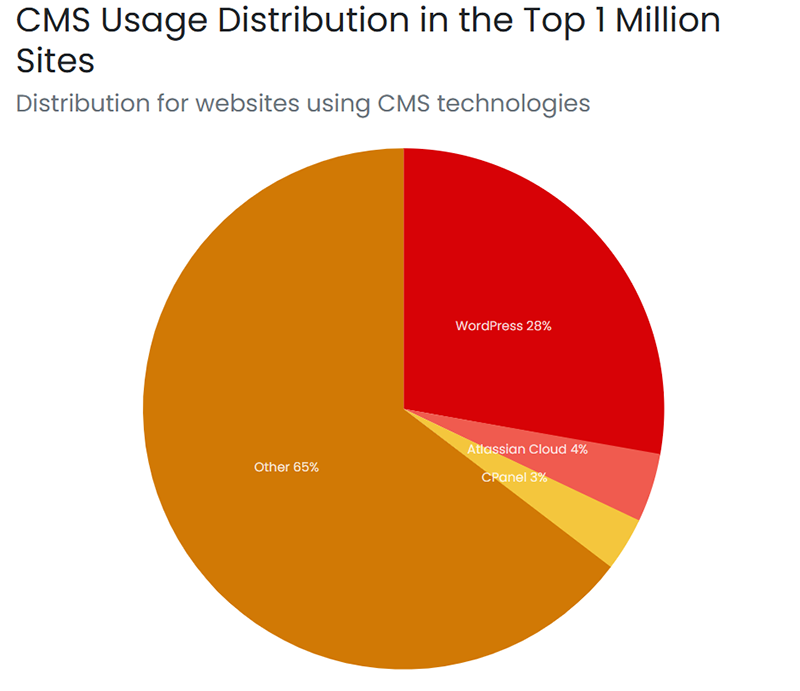
Interestingly, it is also the CMS most frequently compromised, as highlighted in Sucuri's report. Hackers are particularly familiar with standardized solutions like WordPress, making them prime targets for malware attacks and mass hacking incidents.
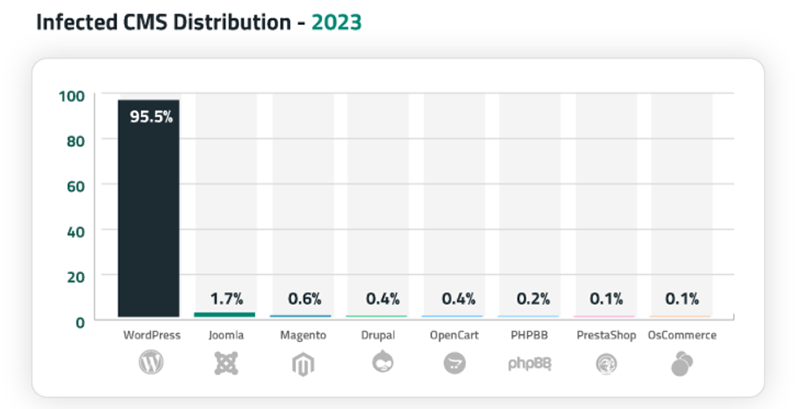
Custom CMSs, designed with specific security measures in mind, reduce these risks by offering unique setups that are less likely to be targeted by mass hacking tactics.
Tailored functionality
A custom CMS allows for the development of features that precisely fit your business processes and user needs, avoiding unnecessary bloat and enhancing specific functionality that is crucial for your operations. This level of customization ensures that every user interaction is streamlined and fully aligned with your business objectives, offering capabilities that off-the-shelf solutions cannot.
Scalability
With a custom CMS, scalability is designed into your system from the start. As your business grows, your CMS can adapt without the limitations imposed by commercial CMS platforms, which might require expensive upgrades or become inefficient under increased loads. This means you can expand your digital presence smoothly and efficiently in response to business needs.
Seamless integration
A custom CMS can be engineered to integrate flawlessly with your existing IT infrastructure, including CRM, ERP, and other essential business systems. This eliminates data silos and facilitates real-time data flows between systems, enhancing productivity and providing a unified view of your operations.
Complete ownership
With a CMS built from scratch you own the codebase which frees you from licensing fees, vendor lock-in, and the uncertainty of relying on third-party developments. You control updates, security patches, and enhancements, and can modify the system as your business strategy evolves. This independence ensures that your digital infrastructure can pivot as quickly as your business needs change.
Investing in a custom CMS offers significant advantages, particularly for businesses with specialized needs that generic platforms cannot meet effectively. This approach not only enhances operational efficiency but also ensures that your digital content management system grows in alignment with your long-term business strategies.
Potential problems of a custom CMS
While a custom CMS can offer tailored solutions perfectly aligned with a business’s needs, there are also some challenges to consider:
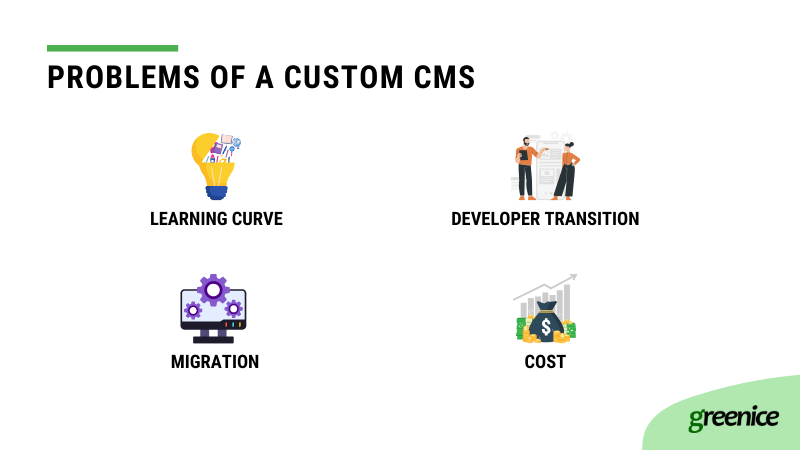
Learning curve for users
Users may find a custom CMS unfamiliar and challenging to navigate, especially when transitioning from widely-used platforms like WordPress, which are supported by extensive user communities and abundant learning resources.
Comprehensive training sessions and detailed user tutorials can be implemented to facilitate ease of use and ensure a smooth transition for all users.
Developer transition and vendor lock-in
Custom CMS solutions often result in vendor lock-in, necessitating reliance on the original developers for future updates or modifications due to the specialized and unique setup of the system.
Utilizing popular technology stacks and well-known frameworks, adhering to best practices, and maintaining thorough documentation can help ensure that new developers can easily take over if needed, reducing the risk of vendor lock-in.
Migration challenges
Switching to a different CMS, whether off-the-shelf or a custom one, often involves complex data migration processes that can disrupt services and negatively impact SEO rankings, posing significant challenges during the transition phase.
Skilled developers can manage the migration process carefully to minimize downtime and preserve SEO performance, ensuring a seamless transition with minimal operational disruption.
Cost considerations
Developing a custom CMS from scratch can be prohibitively expensive, especially for small to medium-sized businesses that may not require all the features of a fully bespoke solution.
White-label solutions (WLS) can serve as a cost-effective alternative that offers a balance between customization and affordability, catering to those who need more than off-the-shelf options but less than a fully custom build. These solutions provide a middle ground, offering some degree of customization without the high costs associated with starting from scratch.
The CMS development process (Step-by-step)
Developing a custom CMS is a meticulous process that involves several critical steps, each tailored to ensure the final product effectively meets the specific needs of the business while offering robust functionality and security.

Planning & requirements gathering
During the discovery phase of any CMS project, whether you're transitioning from an old system or launching a new website, the initial step involves clearly defining what you aim to achieve with the new CMS. It's essential to understand the specific goals and what is expected from the system in terms of functionality and performance.
- Identifying limitations: For those looking to replace an existing CMS, it's crucial to identify the limitations and shortcomings of the current system—what aspects are causing issues or not meeting your needs?
- Retaining useful features: Equally important is recognizing any features of the old CMS that work well and should be retained or replicated.
Once the goals and requirements are clearly outlined, you will be able to decide whether you need an off-the-shelf solution or development from scratch.
Documentation process: Afterwards, all the discussed preferences are carefully documented in a System Requirements Specification (SRS) document. This document serves as the foundational blueprint for the development process, outlining all technical and functional requirements to ensure that the development team has clear directions and aligns perfectly with the project objectives.
Architecture
The architecture of a CMS lays the foundation for how the system will function, scale, and evolve. In this stage, the focus is on creating a structure that supports both the current and future needs of the project.
Traditional vs. headless CMS:
- A traditional CMS tightly couples content management and presentation, suitable for straightforward websites where the same system handles content creation and delivery.
- A headless CMS separates the backend (content management) from the frontend (presentation), using APIs to deliver content to any platform. This makes it ideal for projects needing content distribution across multiple channels like web, mobile, and IoT devices.

The decision between traditional and headless depends on your project needs. Headless CMS offers flexibility for multi-platform content delivery, while traditional is effective for simpler, web-focused projects.
Database and security design:
- Database schema: An efficient database schema is essential for managing data effectively, involving detailed planning of data organization and access.
- User roles and permissions: Setting up specific user roles and permissions is critical for secure access control, ensuring sensitive information is protected and preventing unauthorized access.
Core principles of CMS architecture:
The architecture is developed with scalability, maintainability, and security at its core, allowing for easy updates and expansions. Following industry best practices and incorporating advanced security measures ensures a robust foundation.
This approach ensures the CMS is not only efficient and secure upon deployment but also ready to meet future business needs and technological changes smoothly.
Front-end & back-end implementation
This step involves simultaneous work on both the front-end and back-end components to ensure a cohesive and efficient system.
- The back-end is responsible for data management and business logic. It handles the storage, retrieval, and processing of content, typically using technologies like PHP in WordPress or Drupal, and Python or Node.js in more customized setups.
- The front-end is where this content is displayed to users, often developed with HTML, CSS, JavaScript, and frameworks such as React, Angular, or Vue.js to create an engaging and responsive user experience.
Headless CMS takes a different approach by decoupling the back-end from the front-end. This architecture allows the back-end to operate as a content repository accessible via APIs, which means the front-end can be developed independently using any technology stack that best meets the project's needs. This separation enhances flexibility, enabling developers to innovate more freely in the front-end while maintaining a robust, scalable back-end that can serve content across multiple platforms.
Testing & quality assurance
This step ensures the system is secure, stable, and user-friendly.
- Security testing: This includes penetration testing, vulnerability scanning, and security audits to identify and mitigate potential security vulnerabilities, protecting the CMS from common threats like SQL injection and XSS.
- Performance testing: This testing evaluates how the CMS performs under stress, including load testing to simulate real-life traffic, and scalability testing to ensure the system can handle growth. The goal is to maintain responsiveness and stability, even during high usage periods.
- Usability testing: Usability tests involve real users to ensure the CMS interface is intuitive and easy to navigate. This helps confirm that content managers can effectively use the system without extensive training or encountering usability issues.
Each testing stage is crucial to deliver a CMS that is reliable, efficient, and provides a seamless user experience, preparing it for successful real-world deployment.
Deployment & maintenance
This step marks the transition from development to real-world application.
Once the CMS has passed all testing phases, it is deployed to a live environment. This process involves setting up the server infrastructure, configuring the CMS to the production settings, and ensuring all data integrations work seamlessly. It's crucial to monitor the system closely following deployment to address any issues that may arise as users begin to interact with the system in real scenarios.
After deployment, continuous maintenance is essential to keep the CMS running smoothly and securely. This includes:
- Feature updates: Regularly adding new features and functionality to the CMS to improve user experience and meet evolving business needs.
- Performance optimization: Continuously monitoring the system's performance and making adjustments to handle increased traffic and data as the organization grows.
- Compliance and standards: Ensuring the CMS remains compliant with relevant laws and standards, which may change over time.
Establishing a rapid response system for addressing critical technical issues that could affect the availability and functionality of the CMS.
Regularly scheduled reviews and audits of the CMS help ensure that it not only continues to meet current user needs but is also prepared to adapt to future demands. The goal is to maintain a secure, efficient, and scalable system that supports ongoing business objectives and adapts to the changing digital landscape.
Custom CMS development services & costs
The cost of custom CMS development can vary widely, influenced by several factors such as the complexity of the required features, the specific technologies used, the hourly rates of the development team, and the overall scope and scale of the project.
For more complex systems that require advanced functionalities like multi-level user permissions, integrations with external services, or complex data handling capabilities, the development costs will be higher due to the increased amount of time and expertise required. Conversely, simpler projects with fewer customizations and less demanding technical requirements can be executed at a lower cost.
The cost for this option will start at $15,000 for an MVP. At Greenice, we understand that every business has unique needs and budget constraints. To accommodate this, we offer the option of utilizing white-label solutions—pre-written code scripts that can significantly reduce both development time and cost.
These solutions provide a robust foundation for your CMS, allowing for essential customization without the need to develop every component from scratch. This approach is particularly beneficial for simpler projects or businesses that require a quicker turnaround without sacrificing quality or functionality. By choosing a white-label solution, clients can benefit from a cost-effective, semi-custom platform that still aligns with their specific business requirements.
The cost for this option will start at $5,000 for an MVP.
If you are still hesitant, our manager can provide a free consultation to explain how each option works.
Need help with your custom CMS?
Get a Free Quote Now!Our experience
Below are highlights from our portfolio, showcasing our ability to handle diverse CMS challenges across various sectors.
Continuing medical education platform
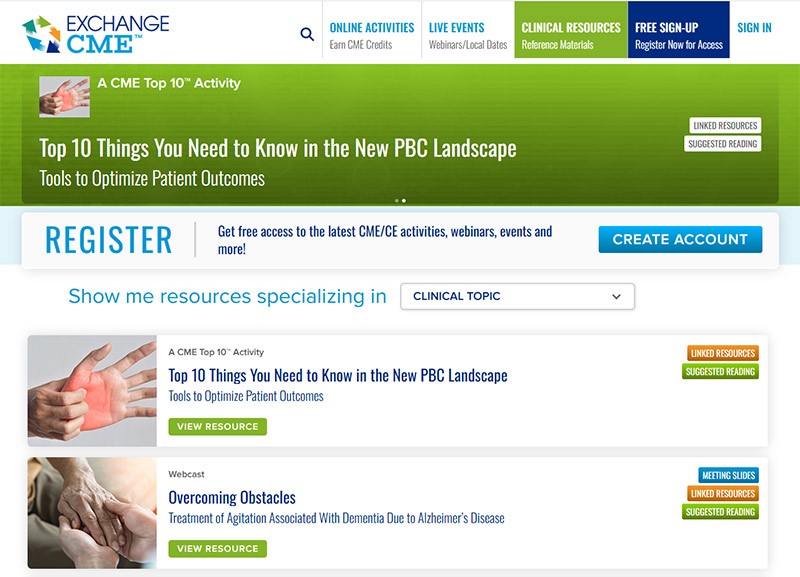
For the exchangeCME project, we developed a comprehensive platform for a Continuous Medical Education (CME) provider to facilitate up-to-date medical learning. This government-regulated platform provides free, quality learning opportunities both online and offline. Our solution includes online courses, live event registration, and robust admin tools for managing content and tracking user progress. Since its launch in 2012, exchangeCME has supported 12,000 members and facilitated over 1,254 live events, significantly enhancing accessibility and efficiency in continuing medical education.
Sports photography platform

For Fourseamimages, a platform serving sports photographers in the U.S., we transitioned from WordPress and PhotoShelter to Laravel. This migration addressed critical issues with high traffic management and complex user profile functionalities. Our redevelopment significantly enhanced site performance, enabling smoother workflow management and a better overall user experience.
Stock media marketplace

In our project with MotionElements, a marketplace for buying and selling stock media, we replaced an outdated system with Laravel to improve performance, security, and manageability. We integrated Elasticsearch to revolutionize the platform's search capabilities, making it quicker and easier for users to locate specific videos and music, thereby streamlining the user experience for media professionals.
Therapy exercise platform
Our work on this therapy exercise platform involved leveraging Elasticsearch to enhance a database of over 15,000 rehabilitation exercises. The platform required a robust search system to help therapists create personalized Home Exercise Programs (HEPs) efficiently. Our solution improved search speed and accuracy, supported multiple languages, and facilitated integration with over 25 Electronic Medical Records (EMR) systems. This not only boosted therapist productivity but also enhanced patient outcomes.
Through these projects, Greenice has demonstrated a profound capability in crafting advanced CMS solutions that cater to complex and high-demand environments, ensuring that our clients receive not only a product that meets their needs but also a platform that enhances their operational capabilities.
Conclusion
Building a custom CMS tailored to your specific needs offers many advantages, including better security, complete customization, and scalability. In our discussion, we covered everything from the simplicity of no-code and low-code options to the flexibility of full-code development. We also compared traditional and headless CMS architectures, each suited to different types of projects.
Choosing the right CMS setup can significantly boost your operational efficiency and help you connect more effectively with your audience. Whether you're upgrading an old system or starting fresh, a custom CMS ensures that every part of your content management system aligns perfectly with your needs.
Ready to take control of your content management or need some advice on the best CMS approach for your project? We're here to help guide you through the process and ensure you get the most from your custom CMS. Let’s chat!
Ready to make your content management seamless?
Get a Free Quote Now!FAQ
How to build a CMS from scratch?
Building a CMS from scratch involves several key steps, starting from planning and requirements gathering, through design and architecture, to implementation, testing, and maintenance. For a detailed step-by-step guide, refer to the "services & cost" section.
Is WordPress considered a CMS?
Yes, WordPress is one of the most popular content management systems available. Unlike fully custom solutions, WordPress offers a vast range of themes and plugins that allow for significant customization but within the confines of its core architecture. This makes it less flexible than a completely custom CMS designed specifically for unique business needs.
Can I build a CMS without coding?
Yes, it is possible to build a CMS without extensive coding knowledge using low-code/no-code platforms. These solutions provide a user-friendly interface for creating web applications and can be a good fit for simpler projects. However, they lack the flexibility and extensive customization capabilities of fully custom-coded platforms.
What is the difference between a site builder and a CMS?
Site builders like Squarespace and Wix are primarily designed for building websites through a visual interface and typically include hosting and technical support. A CMS like WordPress or a custom-coded solution offers more control over content management processes and is more scalable and flexible, suitable for more complex websites and applications.
How do I choose the right CMS for my business?
Choosing the right CMS depends on several factors including your budget, the complexity of the content management needs, the specific integrations required, and your team’s technical capability. Assessing these factors will help you decide whether an off-the-shelf solution like WordPress or a custom CMS would be the best fit to support your business goals effectively.
Rate this article!
5







 Sign in with Google
Sign in with Google
Comments (0)